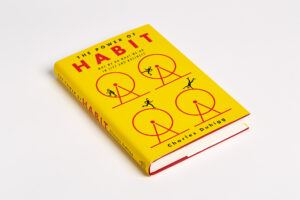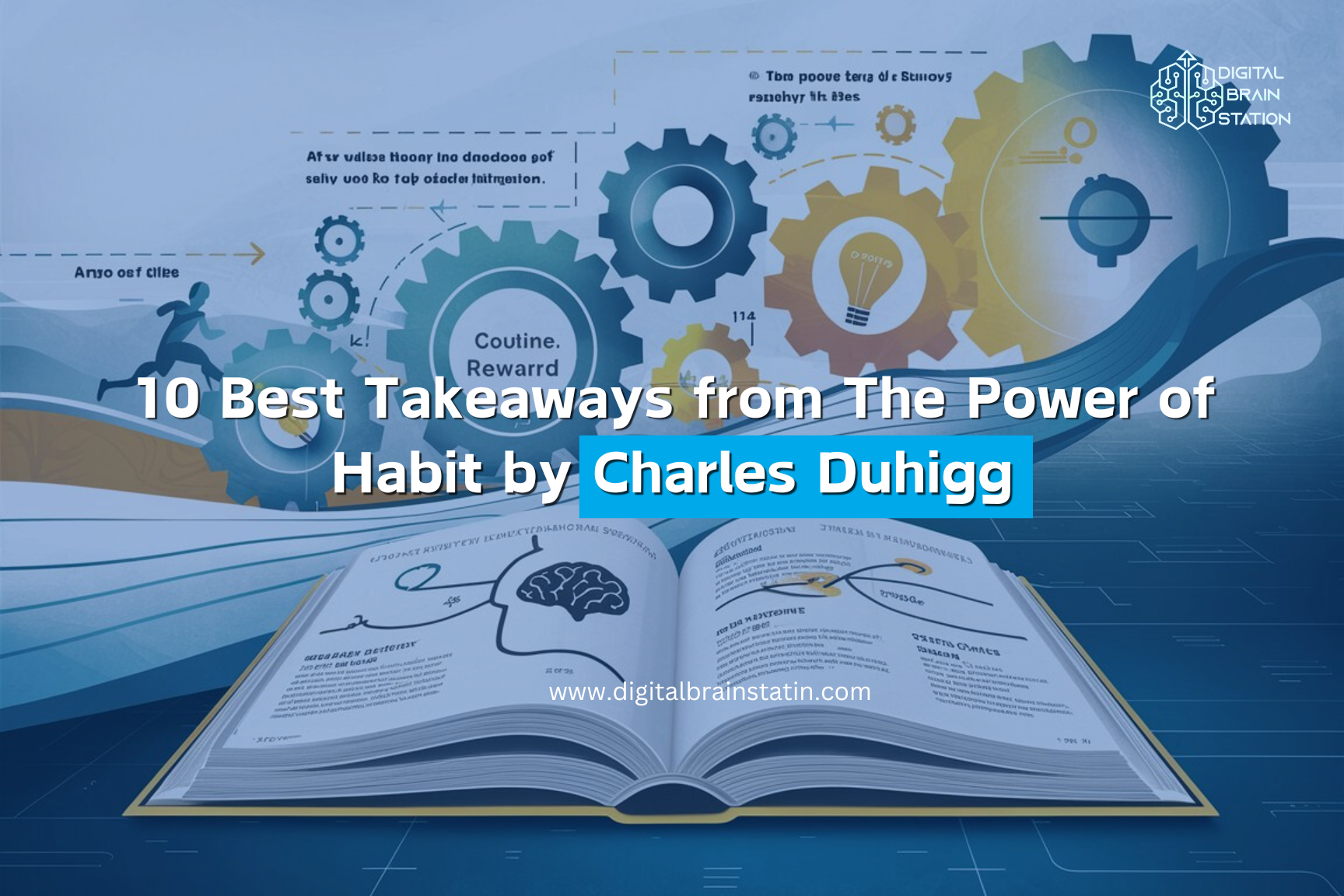Introduction To The Power Of Habit
The Power of Habit by Charles Duhigg is a groundbreaking book. It delves into the science behind habit formation. This book shows how habits work and how to change them.
Brief Overview
The Power of Habit is divided into three parts. The first part explains how habits emerge. The second part looks at how companies exploit habits. The third part explores the role of habits in society.
Duhigg uses real-life examples to explain complex concepts. He discusses stories from various fields like business, sports, and daily life. This makes the book both informative and engaging.
Author’s Background
Charles Duhigg is a Pulitzer Prize-winning journalist. He has worked for The New York Times. His work focuses on the science of productivity and habits.
Duhigg’s background in investigative journalism helps him uncover hidden truths. This makes his writing both credible and insightful.

The Habit Loop
Charles Duhigg’s book “The Power of Habit” uncovers the science of habits. The key concept is the Habit Loop. This loop is the backbone of every habit. Understanding it can help you change any habit.
Cue
The cue is the trigger that starts the habit. It can be anything from a time of day to a specific location. Identifying the cue is the first step to changing a habit. Once you know the cue, you can plan your response.
- Time of day
- Specific location
- Emotional state
- Other people
- Immediate preceding action
Routine
The routine is the action you take in response to the cue. This is the behavior that you want to change or reinforce. To change a habit, you need to swap the current routine with a new one. Keep the cue and reward the same.
- Identify the routine
- Experiment with new behaviors
- Choose a new routine
Reward
The reward is what you get from the routine. It can be a feeling, an object, or any form of gratification. The reward helps your brain remember the habit loop. Knowing the reward can help you modify the habit loop effectively.
| Type of Reward | Example |
|---|---|
| Emotional | Feeling of accomplishment |
| Physical | A treat or snack |
| Social | Praise from others |
Understanding the Habit Loop can transform your life. With practice, you can master your habits.
The Golden Rule Of Habit Change
In “The Power of Habit” by Charles Duhigg, one of the most impactful concepts is the Golden Rule of Habit Change. This principle highlights that to change a habit, you must keep the old cue and deliver the old reward, but insert a new routine. This approach simplifies the process of transforming habits and makes lasting change more attainable.
Identify The Cue
Identifying the cue is the first step in changing a habit. A cue is a trigger that starts your habit loop. It could be a specific time of day, an emotion, or a particular location.
Take note of what happens right before you engage in the habit. Keep a log of your activities and feelings to find patterns.
Change The Routine
Once you identify the cue, focus on changing the routine. This involves replacing the old behavior with a new one.
- Keep the same cue and reward.
- Try different routines to see what works best.
- Make sure the new routine aligns with your goals.
For example, if your habit is eating snacks when stressed, replace it with a walk. This keeps the cue (stress) and reward (relief) but changes the routine.
| Old Habit | New Routine |
|---|---|
| Eating snacks when stressed | Taking a walk when stressed |
| Checking phone when bored | Reading a book when bored |
By following these steps, you can effectively change any habit. The Golden Rule of Habit Change makes this process clear and actionable.
Keystone Habits
Charles Duhigg’s book, The Power of Habit, dives deep into the science of habits. One crucial concept is Keystone Habits. These are habits that can start a chain reaction, leading to the development of other positive habits.
Definition And Importance
Keystone Habits are the habits that hold the power to influence many areas of our lives. They are not just any habits but are central to creating significant life changes. Implementing them can result in remarkable transformations.
For example, exercising regularly might lead to eating healthier, sleeping better, and even being more productive at work. These habits create a ripple effect, impacting various aspects of our lives.
Examples Of Keystone Habits
Duhigg provides multiple examples of keystone habits that can drive positive change. Here are a few:
- Exercise: Regular physical activity boosts mood, energy levels, and productivity.
- Eating Family Dinners: This habit improves family bonding and communication.
- Making Your Bed: A simple act that sets the tone for an organized day.
- Tracking What You Eat: Helps in maintaining a healthy diet and weight.
- Planning Your Day: Increases focus and efficiency, leading to better time management.
These keystone habits might seem small but can lead to substantial improvements in life quality.
| Keystone Habit | Impact |
|---|---|
| Exercise | Boosts mood, energy, and productivity |
| Eating Family Dinners | Improves family bonding and communication |
| Making Your Bed | Sets a tone for an organized day |
| Tracking What You Eat | Maintains a healthy diet and weight |
| Planning Your Day | Increases focus and efficiency |
By focusing on keystone habits, you can create a domino effect. These habits can help you develop other positive behaviors and reach your goals more effectively.
Small Wins
In his book The Power of Habit, Charles Duhigg explores the idea of “Small Wins”. Small wins are minor achievements that can build up to larger successes. They are easy to achieve and create positive momentum. Below, we delve into the benefits of small wins.
Building Momentum
Small wins help in building momentum. Each small win gives a sense of accomplishment. This feeling encourages you to keep going. Small wins are easier to achieve than big goals. They build confidence and keep you motivated.
Imagine you want to run a marathon. Start by running a mile. That small win makes you feel capable. The next day, run two miles. Each small win builds up your endurance. Soon, you will be ready for the marathon.
Psychological Benefits
Small wins have significant psychological benefits. They reduce stress and anxiety. Achieving small wins makes your brain release dopamine. This chemical makes you feel happy and satisfied.
Small wins also make big tasks less overwhelming. Breaking a big task into smaller steps is easier. Each small step is a win, making the big task manageable.
Consider a student with a big project. The project seems too big to handle. Breaking it into smaller parts helps. Completing each part is a small win. This approach makes the project less stressful.
Small wins can also improve your self-esteem. Each win proves you can succeed. This belief builds your confidence over time.
| Benefit | Description |
|---|---|
| Building Momentum | Encourages continued effort through minor achievements. |
| Psychological Benefits | Boosts happiness and reduces stress. |
| Manageable Steps | Breaks down big tasks into smaller, less daunting steps. |
| Improved Self-Esteem | Increases confidence with each small success. |
In summary, small wins are powerful tools for achieving big goals. They build momentum, provide psychological benefits, and make large tasks manageable.
The Role Of Belief
The role of belief in shaping our habits is crucial. Charles Duhigg’s book, The Power of Habit, emphasizes this point. Belief is the glue that holds new habits together. Without belief, habits are hard to form and maintain.
Importance Of Belief
Belief can make or break a habit. It gives us the strength to persist. When we believe change is possible, it becomes easier. Our minds are powerful tools. They can drive us towards our goals. Belief helps us overcome obstacles. It fuels our motivation and keeps us going.
- Belief makes habits stick.
- It provides the willpower needed for change.
- Belief turns intentions into actions.
Group Dynamics And Belief
Groups can influence our beliefs. Being part of a group can strengthen our commitment. Groups provide support and accountability. They reinforce our belief in change. This collective belief can be powerful. It can help us achieve our goals more easily.
| Group Role | Impact on Belief |
|---|---|
| Support | Encourages persistence |
| Accountability | Increases commitment |
| Shared Goals | Strengthens motivation |
Belief, whether personal or collective, is essential. It underpins the entire process of habit formation. Without it, lasting change remains elusive.
The Impact Of Willpower
In “The Power of Habit,” Charles Duhigg explores the transformative power of willpower. Willpower is like a muscle; the more you use it, the stronger it gets. This section will delve into how developing willpower can lead to success.
Developing Willpower
Developing willpower is crucial for personal growth. Duhigg shares that willpower can be trained and strengthened. One effective method is setting small, achievable goals. These goals help build confidence and discipline.
Another key point is the importance of self-control. Studies show that children with better self-control grow up to be healthier and more successful. This highlights the long-term benefits of building willpower.
- Small Goals: Start with simple tasks like making your bed daily.
- Self-Control: Practice delaying gratification for better outcomes.
- Consistency: Repeat positive habits to strengthen willpower.
Willpower And Success
Willpower plays a significant role in achieving success. People with strong willpower are more likely to reach their goals. They can resist temptations and stay focused on their objectives.
Research shows that willpower is a better predictor of success than intelligence. This means that anyone can achieve great things by developing their willpower. Successful people often have strong habits that support their goals.
- Resist Temptations: Avoid distractions to stay on track.
- Stay Focused: Keep your goals in mind and work towards them.
- Build Strong Habits: Create routines that support your objectives.
In summary, willpower is a powerful tool for personal and professional success. By developing and harnessing it, you can achieve your goals and improve your life.
The Power Of Cravings
One of the most intriguing concepts in “The Power of Habit” by Charles Duhigg is the idea of cravings. Cravings are the driving force behind our habits. Understanding cravings can help us manage our habits better.
Cravings And Habits
Cravings are the brain’s way of anticipating a reward. When we perform an action repeatedly, our brain starts craving the reward associated with that action. This is the core of habit formation.
For example, think about the habit of drinking coffee every morning. The craving for the caffeine boost drives the habit. Our brain associates the act of drinking coffee with the feeling of being more alert.
| Habit | Craving |
|---|---|
| Eating a snack | Feeling of satisfaction |
| Checking social media | Desire for social interaction |
| Exercising | Endorphin rush |
Managing Cravings
To change a habit, it’s essential to understand and manage the cravings that drive it. Identifying the craving can help in creating a new habit loop.
Here are some steps to manage cravings:
- Identify the Routine: Note the behavior you want to change.
- Experiment with Rewards: Try different rewards to see what you are craving.
- Isolate the Craving: Determine what triggers your craving. Is it boredom, stress, or something else?
- Change the Routine: Replace the old habit with a new routine that satisfies the same craving.
For instance, if you crave a snack at 3 PM, figure out if it’s hunger or boredom. If it’s boredom, take a short walk or read a book instead. This satisfies the craving without indulging in unhealthy snacks.
Understanding cravings is a powerful tool. It can help us build better habits and lead a more fulfilling life.
Social Influence On Habits
Charles Duhigg’s book, The Power of Habit, delves deep into how habits form and how they influence our lives. One fascinating aspect he explores is the social influence on habits. Social environments and relationships play a critical role in shaping our habits. Understanding these influences can be transformative.
Social Networks
Our social networks have a massive impact on our habits. The people we interact with daily can shape our behaviors. For instance, if your friends exercise regularly, you are more likely to exercise too. This is because habits are contagious within social groups. Below is a table showing the influence of different social relationships:
| Relationship | Influence on Habits |
|---|---|
| Family | Strong |
| Friends | Moderate |
| Colleagues | Weak |
By choosing to spend time with people who have positive habits, you are more likely to adopt those habits yourself. This concept is known as the peer effect.
Peer Pressure
Peer pressure can act as a powerful force in habit formation. It can work both positively and negatively. Positive peer pressure can encourage you to develop good habits. For example, joining a study group can improve your study habits.
Negative peer pressure can push you towards bad habits. If your friends smoke, you might feel pressured to smoke too. It is essential to be aware of the influence your peers have on your habits. Below are some tips to manage peer pressure:
- Choose friends with similar values.
- Communicate your boundaries clearly.
- Seek support from positive influences.
Understanding and managing peer pressure can help you maintain healthier habits. Stay mindful of the people you surround yourself with, as they can significantly impact your behavior.

Applying Habits In Business
The book “The Power of Habit” by Charles Duhigg dives deep into the science of habits. It highlights how habits shape our daily lives. Businesses can greatly benefit from understanding and applying these principles. By leveraging habits, companies can enhance productivity, foster a positive culture, and drive growth.
Corporate Examples
Successful companies use habits to improve their operations. Here are some notable examples:
- Starbucks: Trains employees to handle stress through habit formation. This ensures consistent customer service.
- Alcoa: Focuses on safety habits to drive overall company performance.
- Google: Encourages innovation by fostering a habit of experimentation among employees.
These companies show the power of habits in business. They use habit loops to instill desired behaviors.
Transforming Organizational Habits
Changing organizational habits requires a strategic approach. Here’s how companies can transform their habits:
- Identify Keystone Habits: Focus on habits that can trigger positive changes. For example, prioritizing employee safety can improve overall performance.
- Implement Small Wins: Celebrate small achievements to build momentum. This encourages a culture of continuous improvement.
- Leverage Leaders: Use influential leaders to model desired behaviors. Employees often mimic the habits of their leaders.
By following these steps, businesses can create a positive and productive environment. This helps in achieving long-term goals.
Frequently Asked Questions
What Are The Takeaways Of The Power Of Habit?
“The Power of Habit” reveals how habits form and impact our lives. It emphasizes the habit loop: cue, routine, reward. Change is possible by understanding and altering habits.
What Can We Learn From The Book The Power Of Habit?
The book “The Power of Habit” teaches how habits form and how we can change them to improve our lives. It emphasizes the power of routine, willpower, and small changes. Understanding the habit loop can lead to personal and professional growth.
What Are The Most Significant Concepts You Ve Learned From The Power Of Habit?
The Power of Habit teaches the habit loop, the importance of keystone habits, and the role of belief in changing habits.
What Is The Main Idea Of The Power Of Habit?
The main idea of “The Power of Habit” is that understanding and changing habits can transform lives, businesses, and societies.
Conclusion
Understanding “The Power of Habit” can transform your life. The book offers practical insights into habit formation. Apply these takeaways to boost productivity and achieve goals. Embrace the science of habits for a better, more fulfilling life. Keep exploring and refining your habits for continuous improvement.

